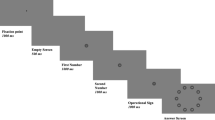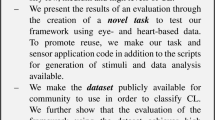Abstract
The research presented in this paper aimed to study the effects of arithmetic and memory tasks (with two levels of difficulty: easy and hard) on human cognitive load using biometric eye tracking techniques. The experiment was conducted with thirty-one participants using iMotions’ integrated biometric platform. In addition to the eye tracking technique, data was also collected by measuring the participants’ performance to the tasks as well as two subjective type of questionnaires including the Single Ease Question (SEQ) and the National Aeronautics and Space Administration Task Load Index Scale (NASA-TLX Scale). A total of 16 metrics were extracted and evaluated, comprising two performance metrics, eight subjective metrics and six eye tracking metrics. Nonparametric Wilcoxon tests were used to find statistically significant differences between metrics at different level of difficulties. Relying on the obtained results from the psychophysiological measure, we concluded that eye tracking metrics can be helpful in analyzing cognitive load during arithmetic and memory recall tasks. At last, based on the overall results, a theoretical model for the prediction of the cognitive load adapted to machine learning techniques has been also proposed.
Access this chapter
Tax calculation will be finalised at checkout
Purchases are for personal use only
Similar content being viewed by others
References
Ahmad, M.I., Keller, I., Robb, D.A., et al.: A framework to estimate cognitive load using physiological data. Pers. Ubiquit. Comput. (2020). https://doi.org/10.1007/s00779-020-01455-7
Babu, D.K.: Study of cognitive load during human-computer interaction using galvanic skin response measurement and facial expression analysis. Master’s thesis. Wroclaw University of Science and Technology, Wrocław (2021)
Berka, C., et al.: EEG correlates of task engagement and mental workload in vigilance, learning, and memory tasks. Aviat. Space Environ. Med. 78(5 II), B231–B244 (2007)
Chen, S., Epps, J., Chen, F.: An investigation of pupil-based cognitive load measurement with low cost infrared webcam under light re- flex interference. In: Proceedings of the Annual International Conference of the IEEE Engineering in Medicine and Biology Society, EMBS, pp. 3202–3205 (2013). https://doi.org/10.1109/EMBC.2013.6610222
Chen, F., et al.: Eye-based measures. In: Chen, F., et al. (eds.) Robust Multimodal Cognitive Load Measurement. HIS, pp. 75–85. Springer, Cham (2016). https://doi.org/10.1007/978-3-319-31700-7_4
De Cock, L., et al.: Taking a closer look at indoor route guidance; usability study to compare an adapted and non-adapted mobile prototype. Spat. Cogn. Comput. 22(1–2), 51–73 (2021). https://doi.org/10.1080/13875868.2021.1885411
Gibson, A., et al.: Assessing usability testing for people living with dementia. In: REHAB 2016: Proceedings of the 4th Workshop on ICTs for improving Patients Rehabilitation Research Techniques, pp. 25–31 (2016). https://doi.org/10.1145/3051488.3051492
Krejtz, K., Duchowski, A.T., Niedzielska, A., Biele, C., Krejtz, I.: Eye tracking cognitive load using pupil diameter and microsaccades with fixed gaze. PLoS ONE 13(9), 1–23 (2018). https://doi.org/10.1371/journal.pone.0203629
Krieglstein, F., Beege, M., Rey, G.D., Ginns, P., Krell, M., Schneider, S.: A systematic meta-analysis of the reliability and validity of subjective cognitive load questionnaires in experimental multimedia learning research. Educ. Psychol. Rev. 34(4), 2485–2541 (2022)
Leppink, J., van Gog, T., Paas, F., Sweller, J.: Cognitive load theory: Researching and planning teaching to maximise learning. Res. Med. Educ. 207–218 (2015). https://doi.org/10.1002/9781118838983.ch18
Morton, J., et al.: Danger, high voltage! Using EEG and EOG measurements for cognitive overload detection in a simulated industrial context. Appl. Ergon. 102, 103763 (2022). https://doi.org/10.1016/j.apergo.2022.103763
Ojha, S.: Study of cognitive load during human-computer interaction using pupillometry and photopletysmography (PPG). Master’s thesis. Wroclaw University of Science and Technology, Wrocław (2021)
Pavlov, Y.G., Kasanov, D., Kosachenko, A.I., Kotyusov, A.I., Busch, N.A.: Pupillometry and electroencephalography in the digit span task. Sci. Data 9(1), 1–6 (2022). https://doi.org/10.1038/s41597-022-01414-2
Ramakrishnan, P., Balasingam, B., Biondi, F.: Cognitive load estimation for adaptive human-machine system automation. In: Learning Control, pp. 35–58. Elsevier (2021). https://doi.org/10.1016/B978-0-12-822314-7.00007-9
Rubio, S., Diaz, E., Martin, J., Puente, J.M.: Evaluation of subjective mental workload: a comparison of SWAT, NASA-TLX, and workload profile methods. Appl. Psychol. 53(1), 61–86 (2004). https://doi.org/10.1111/j.1464-0597.2004.00161
Sarailoo, R., Latifzadeh, K., Amiri, S.H., Bosaghzadeh, A., Ebrahimpour, R.: Assessment of instantaneous cognitive load imposed by educational multimedia using electroencephalography signals. Front. Neurosci. 16(August), 1–16 (2022). https://doi.org/10.3389/fnins.2022.744737
Skaramagkas, V., et al.: Review of eye tracking metrics involved in emotional and cognitive processes. IEEE Rev. Biomed. Eng. 1–19 (2021). https://doi.org/10.1109/RBME.2021.3066072
Tong, S., & Nie, Y.: Measuring designers cognitive load for timely knowledge push via eye tracking. Int. J. Hum.-Comput. Interact. 1–14 (2022). https://doi.org/10.1080/10447318.2022.2057898
Wang, C.C., Cheng, P.K.H., Wang, T.H.: Measurement of extraneous and germane cognitive load in the mathematics addition task: an event-related potential study. Brain Sci. 12(8), 1036 (2022). https://doi.org/10.3390/brainsci12081036
Wong, H.K., Epps, J.: Pupillary transient responses to within-task cognitive load variation. Comput. Methods Programs Biomed. 137, 47–63 (2016). https://doi.org/10.1016/j.cmpb.2016.08.017
Zagermann, J., Pfeil, U., Reiterer, H.: Measuring cognitive load using eye tracking technology in visual computing. In: ACM International Conference Proceeding Series, 24 October 2016, pp. 78–85 (2016). https://doi.org/10.1145/2993901.2993908
Zihisire Muke, P., Trawinski, B.: Concept of research into cognitive load in human computer interaction using biometric techniques. In: Proceedings of the PP-RAI 2019 Conference, Wrocław, Poland, pp. 78–83 (2019)
Zyma, I., et al.: Electroencephalograms during mental arithmetic task performance. Data 4(1), 14 (2019). https://doi.org/10.3390/data4010014
iMotions Biometric Research Platform (8.1), iMotions A/S, Copenhagen, Denmark (2021)
Author information
Authors and Affiliations
Corresponding author
Editor information
Editors and Affiliations
Rights and permissions
Copyright information
© 2023 The Author(s), under exclusive license to Springer Nature Switzerland AG
About this paper
Cite this paper
Muke, P.Z., Kozierkiewicz, A., Pietranik, M. (2023). Investigation and Prediction of Cognitive Load During Memory and Arithmetic Tasks. In: Nguyen, N.T., et al. Computational Collective Intelligence. ICCCI 2023. Lecture Notes in Computer Science(), vol 14162. Springer, Cham. https://doi.org/10.1007/978-3-031-41456-5_63
Download citation
DOI: https://doi.org/10.1007/978-3-031-41456-5_63
Published:
Publisher Name: Springer, Cham
Print ISBN: 978-3-031-41455-8
Online ISBN: 978-3-031-41456-5
eBook Packages: Computer ScienceComputer Science (R0)




